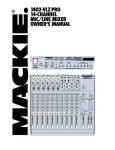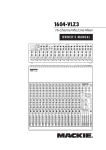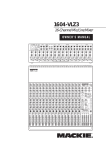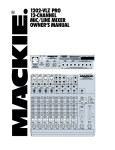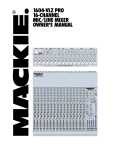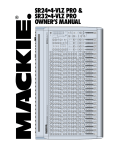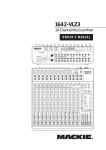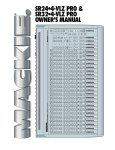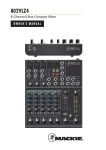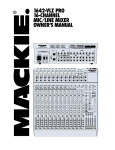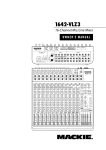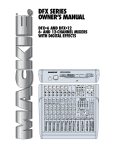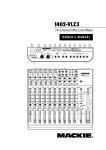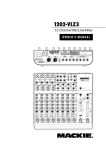Download Mackie 1202-VLZ3 Musical Instrument User Manual
Transcript
1202-VLZ3 12-Channel Mic/Line Mixer OWNER’S MANUAL POWER ON PHANTOM ON WARNING: TO REDUCE THE RISK OF FIRE OR ELECTRIC SHOCK, DO NOT CAUTION SERIAL NUMBER EXPOSE THIS EQUIPMENT TO RAIN OR MOISTURE. DO NOT REMOVE COVER. NO USER SERVICEABLE PARTS INSIDE. REFER SERVICING TO QUALIFIED PERSONNEL. RISK OF ELECTRIC SHOCK DO NOT OPEN MANUFACTURING DATE AVIS: RISQUE DE CHOC ELECTRIQUE — NE PAS OUVRIR UTILISE UN FUSIBLE DE RECHANGE DE MÊME TYPE. DEBRANCHER AVANT DE REMPLACER LE FUSIBLE REPLACE WITH THE SAME TYPE FUSE AND RATING. DISCONNECT SUPPLY CORD BEFORE CHANGING FUSE XDRTM EXTENDED DYNAMIC RANGE MIC PREAMPLIFIERS ARE PROPRIETARY TO MACKIE DESIGNS, INC. ALT OUTPUT CONTROL ROOM L MAIN BALANCED BAL/UNBAL R/4 L R CHANNEL INSERT ( PRE-FADER / PRE EQ TIP SEND / RING RETURN ) BAL/UNBAL 4 L/3 3 2 1 MAIN OUTPUT LEVEL MIC 1 MIC 2 MIC PR E XDR MIC 4 MIC 3 MIC PR E XDR MIC PR E XDR BAL OR UNBAL BAL OR UNBAL LINE IN 2 LOW CUT 75 Hz 18dB/OCT -10dBV C GAIN I U M BAL OR UNBAL LINE IN 3 LOW CUT 75 Hz 18dB/OCT -10dBV C GAIN I U M BAL OR UNBAL LOW CUT 75 Hz 18dB/OCT -10dBV C GAIN I U M C GAIN I U M 0 60 +15dB -45dB 0 60 +15dB -45dB GAIN GAIN GAIN GAIN AUX U OO +15 U +15 OO U AUX U OO +15 U +15 OO U EQ -15 +15 U -15 +15 U +15 U +15 U MID 2.5kHz -15 +15 OO +15 U MID 2.5kHz -15 +15 U +15 PAN -15 L L BAL OR UNBAL BAL OR UNBAL BAL OR UNBAL BAL OR UNBAL R LINE IN 9 –10 AUX U +15 U +15 OO PAN OO +15 U +15 U -15 PAN OO +15 U +15 U PAN EQ +15 U MID 2.5kHz -15 +15 +15 HI 12kHz -15 +15 U +15 PAN LEFT RIGHT 0dB=0dBu 20 +15 U 7 4 LOW 80Hz -15 2 ALT 3–4 0 +15 PAN 2 PAN 4 TAPE 7 10 L R L R 1 L R 2 MUTE L R 3 MUTE L R 4 MUTE L R 5/6 MUTE 7/8 MUTE MUTE L R L R 9/10 11/12 MUTE ALT 3–4 ALT 3–4 ALT 3–4 ALT 3–4 ALT 3–4 PRE FADER PRE FADER PRE FADER PRE FADER PRE FADER PRE FADER PRE FADER SOLO SOLO SOLO SOLO SOLO SOLO SOLO SOLO OO +12dB LEVEL U OO +12dB LEVEL U OO +12dB LEVEL U OO +12dB LEVEL U OO +12dB LEVEL U OO +12dB LEVEL ALT 3–4 U OO +12dB LEVEL 30 MUTE ALT 3–4 U ALT 3–4 20 PRE FADER ASSIGN SSIGN TO MA MAIN IN MIX M U OO CLIP 10 MAIN MIX LOW 80Hz -15 POWER CONTROL ROOM SOURCE MID 2.5kHz -15 LOW 80Hz -15 +15 U U EQ MID 2.5kHz -15 +15 +15 AUX U HI 12kHz -15 LOW 80Hz R LINE IN 11–12 OO HI 12kHz -15 +15 U +15 U U EQ MID 2.5kHz -15 +15 +15 MONO AUX U OO U EQ LOW 80Hz -15 +15 U HI 12kHz -15 +15 U AUX U OO U MID 2.5kHz -15 +15 PAN MONO L R OO LOW 80Hz MAIN OUT MONO LINE IN 7–8 EQ +15 U R L HI 12kHz -15 LOW 80Hz -15 +15 U EQ R R OO HI 12kHz -15 LOW 80Hz -15 +15 +15 U R 2 LINE IN 5–6 AUX U OO HI 12kHz MID 2.5kHz -15 +15 U U EQ HI 12kHz AUX U OO L AUX SEND LOW CUT 75 Hz 18dB/OCT -10dBV 0 60 +15dB -45dB L L MONO LINE IN 4 0 60 +15dB -45dB OO R 2 BAL /UNBAL TAPE TAPE INPUT OUTPUT 1 1 L LINE IN 1 ALL BAL/UNBAL R L /MONO MIC PR E XDR +12dB LEVEL RUDE SOLO LIGHT U OO MAX CTL ROOM /SUBMIX U OO +12dB MAIN MIX LEVEL SET 1202-VLZ3 Important Safety Instructions 1. Read these instructions. 13. Unplug this apparatus during lightning storms or when unused for long periods of time. 2. Keep these instructions. 14. Refer all servicing to qualified service personnel. Servicing is required when the apparatus has been damaged in any way, such as powersupply cord or plug is damaged, liquid has been spilled or objects have fallen into the apparatus, the apparatus has been exposed to rain or moisture, does not operate normally, or has been dropped. 3. Heed all warnings. 4. Follow all instructions. 5. Do not use this apparatus near water. 6. Clean only with dry cloth. 7. Do not block any ventilation openings. Install in accordance with the manufacturer’s instructions. 8. Do not install near any heat sources such as radiators, heat registers, stoves, or other apparatus (including amplifiers) that produce heat. 9. Do not defeat the safety purpose of the polarized or grounding-type plug. A polarized plug has two blades with one wider than the other. A grounding-type plug has two blades and a third grounding prong. The wide blade or the third prong are provided for your safety. If the provided plug does not fit into your outlet, consult an electrician for replacement of the obsolete outlet. 10. Protect the power cord from being walked on or pinched particularly at plugs, convenience receptacles, and the point where they exit from the apparatus. 11. Only use attachments/accessories specified by the manufacturer. 12. Use only with a cart, stand, tripod, bracket, or table specified by the manufacturer, or sold with the apparatus. When a cart is used, use caution when moving the cart/apparatus combination to avoid injury from tip-over. PORTABLE CART WARNING Carts and stands - The Component should be used only with a cart or stand that is recommended by the manufacturer. A Component and cart combination should be moved with care. Quick stops, excessive force, and uneven surfaces may cause the Component and cart combination to overturn. CAUTION AVIS RISK OF ELECTRIC SHOCK DO NOT OPEN RISQUE DE CHOC ELECTRIQUE NE PAS OUVRIR CAUTION: TO REDUCE THE RISK OF ELECTRIC SHOCK DO NOT REMOVE COVER (OR BACK) NO USER-SERVICEABLE PARTS INSIDE REFER SERVICING TO QUALIFIED PERSONNEL ATTENTION: POUR EVITER LES RISQUES DE CHOC ELECTRIQUE, NE PAS ENLEVER LE COUVERCLE. AUCUN ENTRETIEN DE PIECES INTERIEURES PAR L'USAGER. CONFIER L'ENTRETIEN AU PERSONNEL QUALIFIE. AVIS: POUR EVITER LES RISQUES D'INCENDIE OU D'ELECTROCUTION, N'EXPOSEZ PAS CET ARTICLE A LA PLUIE OU A L'HUMIDITE The lightning flash with arrowhead symbol within an equilateral triangle is intended to alert the user to the presence of uninsulated "dangerous voltage" within the product's enclosure, that may be of sufficient magnitude to constitute a risk of electric shock to persons. Le symbole éclair avec point de flèche à l'intérieur d'un triangle équilatéral est utilisé pour alerter l'utilisateur de la présence à l'intérieur du coffret de "voltage dangereux" non isolé d'ampleur suffisante pour constituer un risque d'éléctrocution. The exclamation point within an equilateral triangle is intended to alert the user of the presence of important operating and maintenance (servicing) instructions in the literature accompanying the appliance. Le point d'exclamation à l'intérieur d'un triangle équilatéral est employé pour alerter les utilisateurs de la présence d'instructions importantes pour le fonctionnement et l'entretien (service) dans le livret d'instruction accompagnant l'appareil. 2 1202-VLZ3 15. This apparatus shall not be exposed to dripping or splashing, and no object filled with liquids, such as vases or beer glasses, shall be placed on the apparatus. 16. This apparatus has been designed with Class-I construction and must be connected to a mains socket outlet with a protective earthing connection (the third grounding prong). 17. This apparatus has been equipped with an all-pole, rocker-style AC mains power switch. This switch is located on the rear panel and should remain readily accessible to the user. 18. This apparatus does not exceed the Class A/Class B (whichever is applicable) limits for radio noise emissions from digital apparatus as set out in the radio interference regulations of the Canadian Department of Communications. ATTENTION — Le présent appareil numérique n’émet pas de bruits radioélectriques dépassant las limites applicables aux appareils numériques de class A/de class B (selon le cas) prescrites dans le réglement sur le brouillage radioélectrique édicté par les ministere des communications du Canada. 19. Exposure to extremely high noise levels may cause permanent hearing loss. Individuals vary considerably in susceptibility to noise-induced hearing loss, but nearly everyone will lose some hearing if exposed to sufficiently intense noise for a period of time. The U.S. Government’s Occupational Safety and Health Administration (OSHA) has specified the permissible noise level exposures shown in the following chart. According to OSHA, any exposure in excess of these permissible limits could result in some hearing loss. To ensure against potentially dangerous exposure to high sound pressure levels, it is recommended that all persons exposed to equipment capable of producing high sound pressure levels use hearing protectors while the equipment is in operation. Ear plugs or protectors in the ear canals or over the ears must be worn when operating the equipment in order to prevent permanent hearing loss if exposure is in excess of the limits set forth here. Duration Per Day In Hours Sound Level dBA, Slow Response 8 90 6 92 4 95 3 97 2 100 1.5 102 1 105 0.5 110 0.25 or less 115 Typical Example Duo in small club Subway Train Very loud classical music Dave screaming at Steve about deadlines Loudest parts at a rock concert WARNING — To reduce the risk of fire or electric shock, do not expose this apparatus to rain or moisture. We realize that you must be dying to try out your new 1202-VLZ3. All we ask is that you read this page NOW, and the rest can wait until you’re good and ready. But do read it — you’ll be glad you did. WARNING: Before you plug the AC power cord into the mixer, make sure the VOLTAGE SELECTOR switch is set to the same voltage as your local AC mains supply (see page 12). Other Nuggets of Wisdom For optimum sonic performance, the channel LEVEL knobs and the MAIN MIX knob should be set near the “U” (unity gain) markings. Always turn the MAIN MIX and CONTROL ROOM/ SUBMIX level controls down before making connections to and from your 1202-VLZ3. If you shut down your equipment, turn off your amplifier or powered speakers first. When powering up, turn them on last. Save the shipping box! You may need it someday. Level-Setting Procedure Message to seasoned pros: do not set levels using the old “Turn the GAIN up until the clip light comes on, then back off a hair” trick. When a Mackie mixer clip light comes on, you really are about to clip. We worked and slaved to come up with a better system, one that provides low noise and high headroom. Instant Mixing Here’s how to get going right away, assuming you have a microphone and a keyboard: 1. Plug your microphone into channel 1’s MIC input. 2. Turn on the 1202-VLZ3. Adjusting input levels (Chs. 1–4 only) 3. Perform the Level-Setting Procedure. On the first four channels, it’s not even necessary to hear what you’re doing to set optimal levels. But if you’d like to: Plug headphones into the PHONES jack, then set the CONTROL ROOM/SUBMIX knob about one-quarter of the way up. 4. Connect cords from the MAIN OUTS (XLR, 1⁄4" or RCA, your choice) to your amplifier. 5. Hook up speakers to the amp and turn it on. 6. Turn up the 1202-VLZ3’s channel 1 LEVEL knob to the center detent and the MAIN MIX knob one quarter of the way up. The following steps must be performed one channel at a time: 1. Turn the GAIN, LEVEL and AUX send knobs fully down (counterclockwise). 7. Sing like a canary! 2. Set the EQ knobs at the center detent. 9. Turn that channel’s LEVEL knob to the center detent. 8. Plug your keyboard into stereo channel 5-6. 3. Connect the signal source to the input. 10. Play like a madman and sing like a canary! It’s your first mix! 4. Engage (push in) the SOLO switch. 5. Play something into the selected input. This could be an instrument, a singing or speaking voice, or a line input such as a CD player or tape recorder output. Be sure that the volume of the input is the same as it would be during normal use. If it isn’t, you might have to readjust these levels during the middle of the set. 6. Adjust the channel’s GAIN control so that the display on the right LED meter stays around “0” and never goes higher than “+7.” Owner’s Manual Read This Page! Please write your serial number here for future reference (i.e., insurance claims, tech support, return authorization, make dad proud, etc.) Purchased at: 7. If you’d like to apply some EQ, do so now and return to step 6. 8. Disengage that channel’s SOLO switch. Date of purchase: 9. Repeat for each of channels 1 through 4. Part No. 0019814 Rev. A ©2006 LOUD Technologies Inc. All Rights Reserved. (Only trained professional union stunt hamsters were used to staple this manual.) Owner’s Manual 3 1202-VLZ3 Introduction Thank you for choosing a Mackie professional compact mixer. The 1202-VLZ3 is equipped with our precision-engineered XDRTM Extended Dynamic Range premium studio-grade mic preamp. This icon marks information that is critically important or unique to the 1202-VLZ3. For your own good, read them and remember them. They will be on the final test. Now that you have your 1202-VLZ3, find out how to get the most from it. That’s where this manual comes in. This icon will lead you to in-depth explanations of features and practical tips. While not mandatory, they usually have some valuable nuggets of information. How To Use This Manual Since many of you folks will want to hook up your 1202-VLZ3 immediately, the first pages you will encounter after the table of contents are the ever-popular hookup diagrams. These show typical mixer setups for Record/Mixdown, and Stereo PA. After this section is a detailed tour of the entire mixer. Every feature of the 1202-VLZ3 is described “geographically;” in other words, in order of where it is physically placed on the mixer’s top or rear panel. These descriptions are divided into the first three sections, just as your mixer is organized into three distinct zones: Appendix A is a section on troubleshooting and repair information. Appendix B is a section on connectors: XLR connectors, TRS balanced connectors, TS unbalanced connectors, and Insert connectors. Appendix C shows the technical specifications, and a block diagram showing the internal signal path and general goings-on within the mixer. Patchbay: The patchbay along the top and back, where you connect things. Channel Strip: The eight channel strips where you adjust each channel. Output Section: The output section on the right. Throughout these sections you’ll find illustrations, with each feature numbered. If you’re curious about a feature, simply locate it on the appropriate illustration, notice the number attached to it, and find that number in the nearby paragraphs. Need help with your new mixer? • Visit www.mackie.com and click Support to find: FAQs (Frequently Asked Questions), manuals, addendums, and user forums. • Email us at: [email protected]. • Telephone 1-800-898-3211 to speak with one of our splendid technical support representatives, (Monday through Friday, from 7 a.m. to 5 p.m. PST). 4 1202-VLZ3 Important Safety Instructions .................................. 2 Read This Page! ...................................................... 3 Introduction ............................................................ 4 Hookup Diagrams .................................................... 6 Patchbay Description ............................................... 8 1. MIC INPUTS (Channels 1–4)...................... 8 2. LINE INPUTS (Channels 1–4) ..................... 8 3. LOW CUT (Channels 1–4).......................... 9 4. GAIN (Channels 1–4) ............................... 9 5. STEREO LINE INPUTS ................................ 9 6. IMAGINARY CONTROL ............................ 9 EFFECTS: SERIAL OR PARALLEL? ................ 9 7. STEREO RETURNS................................... 10 8. AUX SEND 1&2 ...................................... 10 9. TAPE INPUT ........................................... 10 10. TAPE OUTPUT ........................................ 10 11. 1⁄4" MAIN OUTS ..................................... 10 12. PHONES ................................................ 11 13. XLR MAIN OUTS ................................... 11 14. XLR MAIN OUTPUT LEVEL SWITCH .......... 11 15. CONTROL ROOM .................................... 11 16. ALT 3–4 OUTPUT ................................... 11 17. CHANNEL INSERT (Channels 1–4 ) ........... 11 18. POWER CONNECTION ............................. 12 Output Section ...................................................... 16 32. MAIN MIX ............................................. 16 33. CONTROL ROOM SOURCE MATRIX .......... 16 34. CONTROL ROOM/SUBMIX ..................... 16 A WORD ABOUT PRE-FADER SOLO (PFL) 17 35. RUDE SOLO LIGHT .................................. 17 36. ASSIGN TO MAIN MIX............................ 17 37. METERS – MANY DISPLAYS IN ONE! ....... 17 38. PRE or POST (AUX 1) ............................ 18 39. AUX 1 MASTER ...................................... 18 40. STEREO RETURNS................................... 18 41. RETURN TO AUX 1 ................................. 19 JACK NORMALLING................................ 19 Appendix A: Service Information ............................ 20 Appendix B: Connections........................................ 21 Appendix C: Technical Information .......................... 24 Owner’s Manual Contents Specifications.................................................. 24 Block Diagram................................................. 25 Track Sheet ..................................................... 26 1202-VLZ3 Limited Warranty ................................ 27 19. FUSE...................................................... 12 20. VOLTAGE SELECTOR ................................ 12 21. POWER SWITCH..................................... 12 22. PHANTOM SWITCH ................................ 12 Channel Strip Description ....................................... 13 “U” LIKE UNITY GAIN ............................. 13 23. LEVEL...................................................... 13 24. PRE-FADER SOLO ................................... 13 25. MUTE/ALT 3–4 ...................................... 13 26. PAN ....................................................... 14 CONSTANT LOUDNESS ! ! ! ...................... 14 3-BAND EQ ............................................ 14 27. LOW EQ ................................................. 14 28. MID EQ .................................................. 14 29. HI EQ..................................................... 15 MODERATION DURING EQ ...................... 15 30. AUX 2 SEND .......................................... 15 31. AUX 1 SEND .......................................... 15 Owner’s Manual 5 1202-VLZ3 Hookup Diagrams 2 3 3 4 4 Stereo Guitar Effects L MONO 6 R Drum Machine Keyboard or other line level input 7 L MONO 8 R 9 CHANNEL INPUTS 5 L MONO 10 R L 11 MONO 12 R In (record) L L IN-TAPE-OUT PHONES CONTROL RM OUT OUTPUTS Tape Player Out (play) 2 4 L 1 R 2 Digital Delay L R 1 L R R R R In Out Stereo Compressor In Out 3 AUX SEND 2 In Mono Compressor Out 1 ALT 3-4 OUT 1 MAIN OUT 1 Multi Effect Processor 2 L MAIN OUT Direct Boxes STEREO RETURNS CHANNEL INSERTS Vocal Mics Headphones for Studio Powered Studio Monitors Headphone Distribution Amp Recording System 6 1202-VLZ3 Powered Studio Monitors for Studio Way-cooler Guitar dad bought your kid brother for his birthday 2 3 3 4 4 Stereo Guitar Effects L MONO 6 R Drum Machine Keyboard or other line level input 7 L MONO 8 R 9 CHANNEL INPUTS 5 L MONO 10 R L 11 MONO 12 R In (record) IN-TAPE-OUT PHONES CNTRL ROOM OUT OUTPUTS Tape Player Out (play) L R L R 2 In Out Stereo Compressor In Out 3 4 L 1 R 2 AUX SEND 2 In Mono Compressor Out 1 ALT 3/4 OUT 1 MAIN OUT 1 L R Multi Effect Processor 1 2 L R Mono EQ Mono Power Stage Monitors Amplifier L R MAIN OUT Direct Boxes STEREO RETURNS CHANNEL INSERTS Vocal Mics Owner’s Manual Bass Guitar Guitar dad bought you for your birthday Stereo EQ Headphones SRM450 Powered Speaker This setup can be easily reconfigured to become a Mono PA setup. A. Stereo sources should feed the left mono side of channel input only. B. Pan each channel hard left. C. Connect Mono PA system to Left main output. SWA1501 Powered Subwoofer SRM450 Powered Speaker SWA1501 Powered Subwoofer Live Stereo PA System Owner’s Manual 7 1202-VLZ3 Patchbay Description MIC 1 MIC PR E XDR MIC 2 MIC PR E XDR MIC 3 MIC PR E XDR MIC 4 1 2 3 4 LINE IN 1 LOW CUT 75 Hz 18dB/OCT -10dBV C GAIN I U M BAL OR UNBAL LINE IN 2 LINE IN 3 LOW CUT 75 Hz 18dB/OCT dBV -10G A C I U M BAL OR UNBAL IN LOW CUT 75 Hz 18dB/OCT -10dBV C GAIN I U M BAL OR UNBAL LINE IN 4 LOW CUT 75 Hz 18dB/OCT dBV -10G A C I U M IN 0 60 +15dB -45dB 0 60 +15dB -45dB 0 60 +15dB -45dB 0 60 +15dB -45dB GAIN GAIN GAIN GAIN R 2 L R R R MAIN OUT AUX SEND MONO MONO MONO L L L L 5 5 BAL OR UNBAL BAL OR UNBAL R R R R LINE IN 5–6 LINE IN 7–8 LINE IN 9–10 1. MIC INPUTS (Channels 1–4) We use phantom-powered, balanced microphone inputs just like the big studio mega-consoles, for exactly the same reason: This kind of circuit is excellent at rejecting hum and noise. You can plug in almost any kind of mic that has a standard XLR male mic connector. Professional ribbon, dynamic, and condenser mics will all sound excellent through these inputs. The 1202-VLZ3’s mic inputs will handle any kind of mic level you can toss at them, without overloading. Be sure to perform the Level-Setting Procedure on page 3. Not every instrument is made to connect directly to a mixer. Guitars commonly need a Direct Injection (DI) box to connect to the mixer's MIC inputs. These boxes convert unbalanced line-level signals from your guitar, into balanced mic-level outputs, and provide signal and impedance matching. They also let you send your gifted guitar renditions over long cables or audio snakes, with minimum interference and high-frequency signal loss. Ask your dealer or guitar maker about their recommendations for a good DI box. PHANTOM POWER Most modern professional condenser mics are equipped for phantom power, which lets the mixer send low-current DC voltage to the mic’s electronics through the same wires that carry audio. (Semi-pro condenser mics often have batteries to accomplish the same thing.) “Phantom” owes its name to an ability to be “unseen” by dynamic mics (Shure SM57/SM58, for instance), which don’t need external power and aren’t affected by it anyway. 5 MONO BAL OR UNBAL BAL OR UNBAL See Appendix B for further details and drawings of the connectors you can use with the 1202-VLZ3. Also see the Channel Strip description on page 13 for details of the signal routing from the XLR and Line inputs. 1202-VLZ3 L L 2 At the risk of stating the obvious, this is where you plug everything in: microphones, line-level instruments and effects, headphones, and the ultimate destination for your sound: a tape recorder, PA system, etc. 8 BAL/UNBAL TAPE TAPE INPUT OUTPUT 1 1 L BAL OR UNBAL ALL BAL/UNBAL R L /MONO MIC PR E XDR 5 LINE IN 11–12 The 1202-VLZ3’s phantom power is globally controlled by the PHANTOM [22] switch on the rear panel. (This means the phantom power for channels 1-4 is turned on and off together.) Never plug single-ended (unbalanced) microphones or instruments into the MIC [1] input jacks if the phantom power is on. Do not plug instrument outputs into the MIC input jacks with phantom power on, unless you know for certain it is safe to do so. ASSIGN TO MAIN MIX 2. LINE INPUTS (Channels 1–4) These four line-inputs share circuitry (but not phantom power) with the mic preamps, and can be driven by balanced or unbalanced sources at almost any level. You can use these inputs for virtually any signal you’ll come across, from instrument levels as low as –40 dB to operating levels of –10 dBV to +4 dBu, since there is 40 dB more gain available than on channels 5–12. To connect balanced lines to these inputs, use a 1⁄4" Tip-Ring-Sleeve (TRS) plug, the type found on stereo headphones. To connect unbalanced lines to these inputs, use a 1⁄4" mono (TS) phone plug or standard instrument cable. The LINE IN inputs 1–4 are a good place to connect older instruments that need more gain. You can correct weak levels by adjusting the corresponding channel’s GAIN control. Each LOW CUT switch, often referred to as a High Pass Filter (all depends on how you look at it), cuts bass frequencies below 75 Hz at a rate of 18 dB per octave. We recommend that you use low-cut on every microphone application except kick drum, bass guitar, bassy synth patches, or recordings of earthquakes. These aside, there isn’t much down there that you want to hear, and filtering it out makes the low stuff you do want much more crisp and tasty. Not only that, but low-cut can help reduce the possibility of feedback in live situations, and it helps to conserve amplifier power. Another way to consider low-cut’s function is that it actually adds flexibility during live performances. With the addition of low-cut, you can safely use low equalization on vocals. Many times, bass shelving EQ can really benefit voices. Trouble is, adding low EQ also boosts stage rumble, mic handling clunks and breath pops. Applying low-cut removes all those problems, so you can add low EQ without losing a woofer. Here’s what the combination of low EQ and low-cut looks like in terms of frequency curves: +15 +15 +10 +10 +5 +5 0 0 –5 –5 –10 –10 20Hz 100Hz 1kHz 10kHz 20kHz 20Hz 100Hz 1kHz 10kHz 20kHz Low Cut with Low EQ Low Cut 4. GAIN (Channels 1–4) If you haven’t already, please read the Level-Setting Procedure on page 3. GAIN adjusts the input sensitivity of the mic and line inputs connected to channels 1 through 4. This allows signals from the outside world to be adjusted to optimal internal operating levels. dBV -10G A U IC M IN 0 60 +15dB -45dB These fully balanced inputs are designed for stereo or mono, balanced or unbalanced signals, from –10 dBV to +4 dBu. They can be used with just about any professional or semi-pro instrument, effect or tape player. In the stereo audio world, an odd-numbered channel usually receives the “left signal.” For example, you would feed the 1202-VLZ3’s line inputs 5-6 a stereo signal by inserting the device’s left output plug into the channel 5 jack, and its right output plug into the channel 6 jack. When connecting a mono device (just one cord), always use the LEFT (MONO) input (jacks 5, 7, 9 or 11) and plug nothing into the RIGHT input (jacks 6, 8, 10 or 12)— this way the signal will appear on both sides. This trick is called “jack normalling.” 6. IMAGINARY CONTROL This control is purely a figment of our imagination. It will come in handy after long hours of mixing, when you really would like a nice cup of tea, a vacation in Hawaii, or a trip to the outer reaches of the Solar System. This is the control for you. Be thankful, you bought a Mackie. We love you man! EFFECTS: SERIAL OR PARALLEL? –15 –15 5. STEREO LINE INPUTS (Channels 5–6, 7–8, 9–10 and 11–12)CAUTION Owner’s Manual 3. LOW CUT (Channels 1–4) If the signal originates through the XLR jack, there will be 0 dB of gain with the knob fully down, ramping to 60 dB of gain fully up. GAIN Through the 1⁄4" input, there is 15 dB of attenuation fully down and 45 dB of gain fully up, with a “U” (unity gain) mark at 10:00. This 15 dB of attenuation can be very handy when you are inserting a very hot signal, or when you want to add a lot of EQ gain, or both. Without this “virtual pad,” this scenario might lead to channel clipping. The next two sections toss the terms “serial” and “parallel” around like hacky sacks. Here’s what we mean by them: “Serial” means that the entire signal is routed through the effects device. Examples: compressor/limiters, graphic equalizers. Line-level sources can be patched through a serial effects device before or after the mixer, or preferably through the insert jacks located on the rear panel (CHANNEL INSERT [17] send/return). Insert Send Insert Return Signal Processor (e.g., Compressor) Dry Signal Processed Signal “Parallel” means that a portion of the signal in the mixer is tapped off to the device (AUX SEND), processed and returned to the mixer (STEREO RETURN) to be mixed with the original “dry” signal. This way, multiple channels can all make use of the same effects device. Examples: reverb, digital delay. Aux Send Aux Return Signal Processor (e.g., Reverb) Output Section Wet Signal Mix Stage Channel Path Dry Signal(s) Processed Signal Dry Signal(s) Owner’s Manual 9 1202-VLZ3 7 MIC 1 MIC 2 MIC PR E XDR MIC PR E XDR MIC 3 MIC PR E XDR MIC 4 LINE IN 1 LOW CUT 75 Hz 18dB/OCT -10dBV C GAIN I U M BAL OR UNBAL LINE IN 2 LINE IN 3 LOW CUT 75 Hz 18dB/OCT dBV -10G A C I U M BAL OR UNBAL IN LOW CUT 75 Hz 18dB/OCT -10dBV C GAIN I U M BAL OR UNBAL GAIN GAIN GAIN GAIN R R 2 R MAIN OUT MONO L L L L BAL OR UNBAL BAL OR UNBAL BAL OR UNBAL BAL OR UNBAL R R R R LINE IN 5–6 LINE IN 7–8 LINE IN 9–10 C GAIN 0 60 +15dB -45dB L MONO I U M 0 60 +15dB -45dB L L AUX SEND LOW CUT 75 Hz 18dB/OCT -10dBV 0 60 +15dB -45dB R 2 BAL/UNBAL TAPE TAPE INPUT OUTPUT 1 MONO LINE IN 4 0 60 +15dB -45dB ALL BAL/UNBAL 1 L BAL OR UNBAL 9 10 11 8 R L /MONO MIC PR E XDR 7. STEREO RETURNS This is where you connect the outputs of your parallel effects devices (or extra audio sources). These balanced inputs are similar to the stereo LINE IN [2] inputs (without EQ, Aux Sends, Pan, Mute, and Solo). The circuits will handle stereo or mono, balanced or unbalanced signals, either instrument level, –10 dBV or +4 dBu. They can be used with just about any pro or semipro effects device on the market. The signals coming into these inputs can be adjusted using the STEREO RETURN [40] knobs before passing onto the main mix bus, see page 19. One Device: If you have just one parallel effects device (two cords), use STEREO RETURN 1 and leave STEREO RETURN 2 unplugged. That way, the unused STEREO RETURN 2 level control can be used to feed STEREO RETURN 1 to your stage monitors, via the RETURN TO AUX 1 [41] switch. Mono Device: If you have an effects device with a mono output (one cord), plug that into STEREO RETURN 1, L/MONO, and leave STEREO RETURN 1, RIGHT, unplugged. This way the signal will be sent to both sides, magically appearing in the center as a mono signal. This won’t work with STEREO RETURN 2 — you’ll need a Y-cord. 8. AUX SEND 1&2 The AUX SEND [31] knobs tap a portion of each channel's signal to provide an output here to feed external parallel effects processors or stage monitoring. See the AUX SEND details on page 15. These 1⁄4" jacks are balanced outputs capable of delivering 22 dBu into a 600 ohm balanced or unbalanced load. MONO 12 LINE IN 11–12 Use these jacks for convenient tape playback of your mixes. You’ll be able to review a mix and then rewind and try another pass without repatching or disturbing the mixer levels. You can also use these jacks with a portable tape or CD player to feed music to a PA system between sets. WARNING: Engaging both the TAPE and ASSIGN TO MAIN MIX buttons in the CONTROL ROOM SOURCE [33] matrix can create a feedback path between TAPE INPUT and TAPE OUTPUT. Make sure your tape deck is not in record, recordpause, or input monitor mode, when you engage these switches, or make sure the CONTROL ROOM / SUBMIX [34] level knob is fully counterclockwise (off). ASSIGN TO MAIN MIX 10. TAPE OUTPUT These unbalanced RCA connections tap the main mix output to make simultaneous recording and PA work more convenient. Connect these to your recorder’s inputs. (See also MAIN MIX [32] on page 16.) Mono Out: If you want to feed a mono signal to your tape deck or other device, simply use an RCA Y-cord to combine these outputs. Do not attempt this with any other outputs on the 1202-VLZ3. 11. 1⁄4" MAIN OUTS These outputs feed the main mix out into the waiting world. You can feed your amplifiers this way, or through the XLR MAIN OUTS [13]. These balanced outputs are capable of delivering 22 dBu into a 600 ohm balanced or unbalanced load. To use these outputs to drive balanced inputs, connect 1⁄4" TRS (Tip–Ring–Sleeve) phone plugs like this: Tip = + (hot) 9. TAPE INPUT These RCA jacks are designed to work with semipro as well as pro recorders. To compensate for typically low levels, signals coming in here will be automatically boosted by 6 dB. Connect your tape recorder’s outputs here, using standard hi-fi (RCA) cables. Ring = –(cold) Sleeve = Ground For most music recording and PA applications, unbalanced lines are fine. To drive unbalanced inputs, connect 1⁄4" TS (Tip–Sleeve) phone plugs like this: Tip = + (hot) Sleeve = Ground 10 1202-VLZ3 PHANTOM ON WARNING: CAUTION SERIAL NUMBER TO REDUCE THE RISK OF FIRE OR ELECTRIC SHOCK, DO NOT EXPOSE THIS EQUIPMENT TO RAIN OR MOISTURE. DO NOT REMOVE COVER. NO USER SERVICEABLE PARTS INSIDE. REFER SERVICING TO QUALIFIED PERSONNEL. RISK OF ELECTRIC SHOCK DO NOT OPEN MANUFACTURING DATE AVIS: RISQUE DE CHOC ELECTRIQUE — NE PAS OUVRIR UTILISE UN FUSIBLE DE RECHANGE DE MÊME TYPE. DEBRANCHER AVANT DE REMPLACER LE FUSIBLE REPLACE WITH THE SAME TYPE FUSE AND RATING. DISCONNECT SUPPLY CORD BEFORE CHANGING FUSE XDRTM EXTENDED DYNAMIC RANGE MIC PREAMPLIFIERS ARE PROPRIETARY TO MACKIE DESIGNS, INC. BAL/UNBAL CHANNEL INSERT ( PRE-FADER / PRE EQ TIP SEND / RING RETURN ) BAL/UNBAL L R 13 ALT OUTPUT CONTROL ROOM L MAIN BALANCED R/4 L/3 4 2 3 1 MAIN OUTPUT LEVEL 14 12. PHONES This stereo jack will drive any standard headphone to very loud levels. Walkperson-type phones can also be used with an appropriate adapter. To learn how signals are routed to these outputs, see SOURCE MATRIX [33] on page 16. If you’re wiring your own cable for the PHONES output, follow standard conventions: Tip = Left channel Ring = Right channel Sleeve = Common ground WARNING: When we say the headphone amp is loud, we’re not kidding. It can cause permanent ear damage. Even intermediate levels may be painfully loud with some earphones. BE CAREFUL! Always turn the CTL ROOM/ SUBMIX [34] knob all the way down before connecting headphones. Keep it down until you’ve put the phones on. Then turn it up slowly. Why? “Engineers who fry their ears find themselves with short careers.” 13. XLR MAIN OUTS Use these to send the main mix out into the line-level balanced inputs of your amplifier or powered speakers. 15 16 17 loed channels, or the Tape input. The volume is adjustable with the CONTROL ROOM/SUBMIX [34]knob. Owner’s Manual POWER ON These balanced outputs are capable of delivering 22 dBu into a 600 ohm balanced or unbalanced load. 16. ALT 3–4 OUTPUT These 1⁄4" outputs are the sum of any channels that have the MUTE/ALT 3-4 [25] switch pressed in (see page 13 for the tender details). These balanced outputs are capable of delivering 22 dBu into a balanced or unbalanced load. 17. CHANNEL INSERT (Channels 1–4 ) These rear-panel jacks are where you connect serial effects such as compressors, equalizers, de-essers, or filters. Since most people don’t have more than a few of these gadgets, we’ve included inserts for just the first four channels. If you want to use this kind of processing on channels 5 through 12, simply patch through the processor before you plug into the 1202-VLZ3. The channel insert points are after the GAIN [4] and LOW CUT [3] controls, but before the channel’s EQ [27] and LEVEL [23] controls. The send (tip) is lowimpedance (120 ohms), capable of driving any line-level device. The return (ring) is high-impedance (over 2.5 k ohms) and can be driven by almost any device. ASSIGN TO MAIN MIX These low-impedance outputs are fully balanced and capable of driving +4 dBu lines with up to 28 dB of headroom. This output is 6 dB hotter than other outputs. tip SEND to processor ring sleeve (TRS plug) “tip” 14. XLR MAIN OUTPUT LEVEL SWITCH Engaging this switch reduces the level of the balanced XLR main outputs by 40 dB, so you can feed the microphone input of, say, another mixer. (You can safely connect the XLR outputs into an input that provides 48V phantom power.) 15. CONTROL ROOM These 1⁄4" outputs are provided so you can listen to something other than the main mix. The source is selected using the SOURCE MATRIX [33] switches (see page 16). You can choose to listen to the main mix, the Alt 3-4 stereo bus (see MUTE/ALT 3-4 on page 13), So- This plug connects to one of the mixer’s Channel Insert jacks. “ring” RETURN from processor See Appendix B for details and drawings about Insert cables, and a diagram showing three ways to use the jacks. Besides being used for inserting external devices, these jacks can also be used as channel direct outputs; post-GAIN, post-LOW CUT, and pre EQ. In fact, Mackie mic preamps have become so famous, that people buy these mixers just to have four of these in their arsenal. Owner’s Manual 11 1202-VLZ3 21 22 POWER ON PHANTOM ON WARNING: CAUTION 18 19 SERIAL NUMBER TO REDUCE THE RISK OF FIRE OR ELECTRIC SHOCK, DO NOT EXPOSE THIS EQUIPMENT TO RAIN OR MOISTURE. DO NOT REMOVE COVER. NO USER SERVICEABLE PARTS INSIDE. REFER SERVICING TO QUALIFIED PERSONNEL. RISK OF ELECTRIC SHOCK DO NOT OPEN MANUFACTURING DATE AVIS: RISQUE DE CHOC ELECTRIQUE — NE PAS OUVRIR UTILISE UN FUSIBLE DE RECHANGE DE MÊME TYPE. DEBRANCHER AVANT DE REMPLACER LE FUSIBLE REPLACE WITH THE SAME TYPE FUSE AND RATING. DISCONNECT SUPPLY CORD BEFORE CHANGING FUSE XDRTM EXTENDED DYNAMIC RANGE MIC PREAMPLIFIERS ARE PROPRIETARY TO MACKIE DESIGNS, INC. BAL/UNBAL R 20 ALT OUTPUT CONTROL ROOM L MAIN BALANCED CHANNEL INSERT ( PRE-FADER / PRE EQ TIP SEND / RING RETURN ) BAL/UNBAL L R/4 L/3 4 3 2 1 MAIN OUTPUT LEVEL 18. POWER CONNECTION 21. POWER SWITCH Just in case you lose the cord provided with the 1202VLZ3, its power jack accepts a standard 3-prong IEC cord like those found on most professional recorders, musical instruments, and computers. Press the top of this rocker switch inwards to turn on the mixer. The power LED on the top surface of the mixer will glow with happiness, or at least it will if you have the mixer plugged in to a suitable live AC mains supply. WARNING: Before you plug the AC power cord into the 1202-VLZ3, you must make sure that the VOLTAGE SELECTOR [20] slide switch is set to the same voltage as your local AC mains supply. Press the bottom of this switch to turn off the mixer, whenever you feel that this would be a safe thing to do. Half-way through Mad Mike's Heavy Metal guitar solo might not be such a good time. WARNING: Disconnecting the plug’s ground pin can be dangerous. Please don’t do it. As a general guide, you should turn on your mixer first, before the power amplifier or powered speakers, and turn it off last. This will reduce the possibilities of any turn-on, or turn-off thumps in your speakers. 19. FUSE The 1202-VLZ3 is fused for your (and its own) protection. If you suspect a blown fuse, disconnect the cord, pull the fuse drawer out (located just below the cord receptacle) and replace the fuse with a 500 mA (0.5 amps) SLO BLO 5x20mm, available at electronics stores or your dealer. Use a 250 mA fuse if your local voltage is 220-240 VAC. If two fuses blow in a row, something is very wrong. Please call our toll-free number 1-800-898-3211 from within the U.S. (or the distributor in your country) and find out what to do. 20. VOLTAGE SELECTOR WARNING: Before you plug the AC power cord into the 1202-VLZ3, you must make sure that this slide switch is set to the same voltage as your local AC main supply. Only slide the voltage switch with the power cord unplugged. Use a flat headed screwdriver to slide the switch if needed. The switch allows you to use the mixer in different countries and voltages, meet interesting people from other cultures, and entertain them with your unique blend of Rockabilly Funkadelia Thrash Metal. 12 1202-VLZ3 22. PHANTOM SWITCH This global rocker switch controls the phantom power supply for condenser microphones plugged into channel MIC [1] inputs (see page 8). Press the top of the switch inwards to engage phantom power to the four MIC inputs. Press the bottom of the switch to turn it off. When turned on (or off), the phantom power circuitry takes a few moments for voltage to ramp up (or down). This is perfectly normal. Just like me. Oh, and my imaginary friend Lazlo who helps me write all the manuals. Say hello to the nice folks Lazlo. ASSIGN TO MAIN MIX The eight channel strips look alike, and function identically. The only difference is that the four on the left are for individual mics or mono instruments and have more gain available, while the next four are for either stereo or mono line-level sources. (Each of the stereo channel strips is actually two complete circuits. The controls are linked together to preserve stereo.) We’ll start at the bottom and work our way up… “U” LIKE UNITY GAIN Mackie mixers have a “U” symbol on almost every level control. This “U” stands for “unity gain,” meaning no change in signal level. Once you have adjusted the input signal to line-level, you can set every control at “U” and your signals will travel through the mixer at optimal levels. What’s more, all the labels on our level controls are measured in decibels (dB), so you’ll know what you’re doing level-wise if you choose to change a control’s settings. AUX U OO OO +15 U +15 U EQ HI 12kHz -15 +15 U MID 2.5kHz -15 +15 U LOW 80Hz -15 +15 PAN L R 25 24 1 MUTE ALT 3–4 PRE FADER SOLO U 23 You won’t have to check it here and check it there, as you would with some other mixers. In fact, some don’t even have any reference to actual dB levels at all! You were smart — you bought a Mackie. 23. LEVEL This adjusts the channel’s level… from off, to unity gain at the detent, on up to 12 dB of additional gain. The LEVEL knob is the equivalent of a channel fader, so sometimes we lapse and say the word fader. Channels 1 through 4 use mono controls, and channels 5 through 12 use stereo controls, and so they may feel slightly different. Not a problem. 24. PRE-FADER SOLO OO +12dB LEVEL This lovable switch allows you to hear signals through your headphones or control room without having to route them to the main mix or ALT 3-4 mix. You don’t even have to have the channel’s LEVEL [23] knob turned up. Folks use solo in live work to preview channels before they are let into the mix, or to just check out what a particular channel is up to anytime during a session. You can solo as many channels at a time as you like. Solo is also the key player in the Level-Setting Procedure on page 3. Soloed channels are sent to the SOURCE mix, which ultimately feeds your control room, phones and meter display. Whenever SOLO is engaged, all SOURCE selections (MAIN MIX, ALT 3-4 and TAPE) are defeated, to allow the soloed signal to do just that — solo! Owner’s Manual Channel Strip Description WARNING: PRE-FADER SOLO taps the channel signal before the LEVEL knob. If you have a channel’s LEVEL knob set below “U” (unity gain), SOLO won’t know that and will send a unity gain signal to the control room, phones and meter display. That may result in a startling level boost at these outputs. 25. MUTE/ALT 3–4 The dual-purpose MUTE/ALT 3–4 bus is a Mackie signature. When Greg was designing our first product, he had to include a mute switch for each channel. Mute switches do just what they sound like they do. They turn off the signal by “routing” it into oblivion. “Gee, what a waste,” Greg reasoned. “Why not have the mute button route the signal somewhere else useful… like a separate stereo bus?” So MUTE/ALT 3–4 really serves two functions — muting (often used during a mixdown or live show), and signal routing (for multitrack and live work) where it acts as an extra stereo bus. To use this as a MUTE switch, all you have to do is not use the ALT 3–4 [16] outputs. Then, whenever you press this switch, you will assign a channel to these unused outputs, disconnecting it from the main mix, and effectively muting the channel. To use this as an ALT 3–4 switch, all you have to do is connect the ALT 3–4 outputs to whatever destination you desire. Here are two popular examples: When doing multitrack recording, use the ALT 3–4 outputs to feed your multitrack. With most decks, you can "mult" the ALT 3–4 [16] outputs, using Y-cords or mults, to feed multiple tracks. So, take ALT OUTPUT L and send it to tracks 1, 3, 5 and 7, and ALT OUTPUT R and send it to tracks 2, 4, 6 and 8. Now, tracks that are in Record or Input modes will hear the ALT 3–4 signals, and tracks in Playback or Safe modes will ignore them. When doing live sound or mixdown, it’s often handy to control the level of several channels with one knob. That’s called subgrouping. Simply assign these channels to the ALT 3–4 mix, engage ALT 3–4 in the SOURCE [33] matrix, and the signals will appear at the CONOwner’s Manual 13 1202-VLZ3 TROL ROOM [15] and PHONES [12] outputs. If you want the ALT 3–4 signals to go back into the main mix, engage the ASSIGN TO MAIN MIX [36] switch, and the CONTROL ROOM/SUBMIX [34] level control becomes the one knob to control the levels of all the channels assigned to ALT 3–4. Another way to do the same thing is assign the channels to the ALT 3–4 mix, then patch out of the ALT 3–4 OUTPUT [16]back into an unused stereo channel LINE INPUT [2]. If that’s your choice, don’t ever engage the MUTE/ALT 3–4 switch on that stereo channel, or you’ll have every dog in the neighborhood howling at your feedback loop. Another benefit of the ALT 3–4 feature is that it can act as a “SIP” (Solo-In-Place): just engage a channel's MUTE/ALT 3–4 switch and the ALT 3–4 switch in the SOURCE matrix and you’ll get that channel, all by itself, in the control room and phones. MUTE/ALT 3–4 is one of those controls that can bewilder newcomers, so take your time and play around with it. Once you’ve got it down, you’ll probably think of a hundred uses for it! AUX U 31 OO +15 U 30 OO +15 U EQ 29 HI 12kHz -15 +15 U 28 MID 2.5kHz -15 +15 U 27 LOW 80Hz -15 +15 PAN 26 L R 1 MUTE ALT 3–4 PRE FADER SOLO U OO +12dB LEVEL 26. PAN PAN adjusts the amount of channel signal sent to the left versus the right outputs. On mono channels (ch. 1–4 or 5–12 with connections to the L input only) these controls act as pan pots. On stereo channels (5–12) with stereo connections to L and R inputs, the PAN knob works like the balance control on your home stereo. PAN determines the fate of the main mix and ALT 3–4 mix. With the PAN knob hard left, the signal will feed either MAIN OUT L (bus 1) or ALT OUTPUT L (bus 3), depending on the position of the ALT 3–4 switch. With the knob hard right, the signal feeds MAIN OUT R (bus 2) or ALT OUTPUT R (bus 4). CONSTANT LOUDNESS ! ! ! The 1202-VLZ3’s PAN controls employ a design called “Constant Loudness.” It has nothing to do with living next to an all-night disco. As you turn the PAN [26] knob from left to right (thereby causing the sound to move from the left to the center to the right), the sound will appear to remain at the same volume (or loudness). If you have a channel panned hard left (or right) and reading 0 dB, it must dip down about 4 dB on the left (or right) when panned center. To do otherwise (the way Brand X compact mixers do) would make the sound appear much louder when panned center. 3-BAND EQ The 1202-VLZ3 has 3-band equalization at carefully selected points — LOW shelving at 80 Hz, MID peaking at 2.5 kHz, and HI shelving at 12 kHz. “Shelving” means that the circuitry boosts or cuts all frequencies past the specified frequency. For example, rotating the LOW EQ knob 15 dB to the right boosts bass starting at 80 Hz and continuing down to the lowest note you never heard. “Peaking” means that certain frequencies form a “hill” around the center frequency — 2.5 kHz in the case of the MID EQ. 27. LOW EQ This control gives you up to 15 dB boost or cut below 80 Hz. The circuit is flat (no boost or cut) at the center detent position. This frequency represents the punch in bass drums, bass guitar, fat synth patches, and some really serious male singers. +15 +10 +5 0 –5 –10 –15 20Hz 1202-VLZ3 1kHz 10kHz 20kHz 1kHz 10kHz 20kHz +15 +10 +5 Used in conjunction with the LOW CUT [3] switch, you can boost the LOW EQ without injecting a ton of subsonic debris into the mix. 0 –5 –10 –15 20Hz 100Hz Low EQ with Low Cut 28. MID EQ +15 Short for “midrange,” +10 this knob provides 15 dB +5 of boost or cut, centered at 0 2.5 kHz, also flat at the cen- –5 –10 ter detent. Midrange EQ –15 is often thought of as the 20 100 1k 10k 20k most dynamic, because the Mid EQ frequencies that define any particular sound are almost always found in this range. You can create many interesting and useful EQ changes by turning this knob down as well as up. Hz 14 100Hz Low EQ Hz Hz Hz Hz This control gives you up to 15 dB boost or cut above 12 kHz, and it is also flat at the detent. Use it to add sizzle to cymbals, and an overall sense of transparency, or edge to keyboards, vocals, guitar and bacon frying. Turn it down a little to reduce sibilance, or to hide tape hiss. Each AUX send level ranges from off through unity (the center detent position) on up to 15 dB of extra gain (when turned fully clockwise). Chances are you’ll never need this extra gain, but it’s nice to know it’s there if you do. +15 +10 +5 0 –5 –10 –15 20Hz 100Hz 1kHz 10kHz 20kHz Channel 5–12 AUX knobs control the mono sum of the channel’s stereo signals for each AUX send. For instance, channel 5 (L) and 6 (R) mix together to feed that channel’s AUX send knobs. High EQ MODERATION DURING EQ With EQ, you can also screw things up royally. We’ve designed a lot of boost and cut into each equalizer circuit, because we know everyone will occasionally need that. But if you max the EQs on every channel, you’ll get mix mush. Equalize subtly and use the left sides of the knobs (cut), as well as the right (boost). Very few gold-record-album engineers ever use more than about 3 dB of EQ. If you need more than that, there’s usually a better way to get it, such as placing a mic differently (or using a different kind of mic entirely). We recommend going into a stereo reverb in mono and returning in stereo. We have found that on most “stereo” reverbs the second input just ties up an extra AUX send and adds nothing to the sound. There are exceptions, so feel free to try it both ways. If your effects device is true stereo all the way through, use AUX 1 to feed its left input and AUX 2 to feed the right input. Owner’s Manual 29. HI EQ Still with us? Good for you. Here come the tricky parts, the output or master section where the mixing is really done. We have even started it on a new page: 30. AUX 2 SEND 31. AUX 1 SEND These knobs allow you to tap a portion of each channel signal out to another source for parallel effects processing or stage monitoring. AUX send levels are controlled by these knobs and by the AUX 1 MASTER [39]. These are more than just effects and monitor sends. They can be used to generate separate mixes for recording or “mix-minuses” for broadcast. By using AUX 1 in the PRE mode, these mix levels can be obtained independently of the channel’s LEVEL control. AUX 1 in post mode and AUX 2 are post-LOW CUT, post-EQ and post-LEVEL. That is, the sends obey the settings of these controls. AUX 1 in PRE mode follows the EQ and LOW CUT settings only. PAN and LEVEL have no effect on the PRE send (see diagram below). LEVEL INPUT GAIN LO CUT INSERT PAN EQ MAIN / ALT "POST" SIGNAL OBEYS MUTE STATUS AUX 2 KNOB “Pre vs. Post” TO AUX SEND 2 LEVEL Signal Flow Diagram "POST" SIGNAL "PRE" SIGNAL AUX 1 KNOB TO AUX SEND 1 LEVEL AUX SEND 1 PRE/POST SWITCH (IN MASTER SECTION) Owner’s Manual 15 1202-VLZ3 Output Section 33. CONTROL ROOM SOURCE MATRIX Typically, the engineer sends the main mix to an audience (if live) or a mixdown deck (if recording). But what if the engineer in the control room needs to hear something other than the main mix? With the 1202VLZ3, the engineer has several choices of what to listen to. This is one of those tricky parts, so brace yourself. POWER 33 CONTROL ROOM SOURCE LEFT RIGHT 0dB=0dBu 20 CLIP 10 7 MAIN MIX 4 37 Selections made in the source matrix deliver stereo signals to the control room, phones and meter display. With no switches engaged, there will be no signal at these outputs and no meter indication. 2 ALT 3–4 0 2 4 TAPE 7 LEVEL SET 10 20 36 30 ASSIGN SSIGN TO MA MAIN IN M MIX 35 RUDE SOLO LIGHT U U 34 OO MAX CTL ROOM /SUBMIX 32 OO Via these SOURCE switches, you can choose to listen to any combination of main mix, ALT 3-4 and Tape. By now, you probably know what the main mix is. ALT 3-4 is that additional stereo mix bus. Tape is the stereo signal coming in from the TAPE INPUT [9] jacks. +12dB MAIN MIX 32. MAIN MIX This knob controls the levels of signals sent to the main outputs: XLR [13] and 1⁄4" [11] and RCA TAPE OUTPUT [10]. All channels and STEREO RETURNS [7] that are not muted or turned fully down will wind up in the main mix. Fully counterclockwise is off, the center detent is unity gain, and fully clockwise provides 12 dB of additional gain. This additional gain will typically never be needed, but once again, it’s nice to know it’s there. This is the knob to turn down at the end of the song when you want The Great Fade-Out. The exception is the solo function. Regardless of the source selection, engaging a channel’s SOLO [24] switch will replace that selection with the solo signal, also sent to the control room, phones and right meter (the left meter becomes inactive). This is what makes the Level-Setting Procedure so easy to do. WARNING: Engaging both the TAPE and ASSIGN TO MAIN MIX [36] buttons can create a feedback path between TAPE INPUT [9] and TAPE OUTPUT [10]. Make sure your tape deck is not in record, record-pause, or input-monitor mode when you engage these switches, or make sure the CONTROL ROOM / SUBMIX 34] level knob is fully counterclockwise (off). Now you know how to select the signals to send to the engineer’s control room or phones. From there, these signals all pass through the same level control: 34. CONTROL ROOM/SUBMIX This knob controls the levels of both the stereo CONTROL ROOM [15] and PHONES [12] outputs. The control range is from off through unity gain at the detent, with 10 dB of extra gain (when turned fully clockwise). When MAIN MIX is your control room source selection, those signals will now pass through two level controls on the way to your control room amp and phones — the MAIN MIX [32] knob and this CONTROL ROOM / SUBMIX knob. This way, you can send a nice healthy level to the main output (MAIN MIX knob at “U”), and a quiet level to the control room or phones (CONTROL ROOM / SUBMIX knob wherever you like it). When ALT 3-4 or TAPE is selected, or SOLO [24] is engaged, the CONTROL ROOM / SUBMIX knob will be the only one controlling these levels (channel controls not withstanding). 16 1202-VLZ3 A WORD ABOUT PRE-FADER SOLO (PFL) Engaging a channel’s SOLO [24] switch will cause this dramatic turn of events: Any existing control room source selections will be replaced by the solo signal, appearing in the control room, headphones, and in the right meter. The audible solo levels are then controlled by the CONTROL ROOM / SUBMIX [34] knob. The solo levels appearing on the right meter display are not controlled by anything — you wouldn’t want that. You want to see the actual channel level on the meter display regardless of how loud you’re listening. “PRE-FADER” SOLO means that the channel signal is being tapped before the channel’s LEVEL [23] knob (not really a fader in this case, but we were afraid you’d laugh if we called it Pre-Knob Solo). It does, however, obey GAIN [4], LOW CUT [3] and EQ [27] settings, making it the perfect tool for quick inspections of suspect channels. The channel’s PAN [26] and MUTE/ALT 3-4 [25]settings have no effect on the solo signal. Note: For stereo channels 5-12, the solo signal is the mono sum of the left (odd-numbered) and right (evennumbered) signals for that channel strip. WARNING: PRE-FADER SOLO [24] taps the channel signal before the LEVEL knob. If you have a channel’s LEVEL knob set below “U” (unity gain), SOLO won’t know that, and will send a unity gain signal to the control room, phones and meter display, that may result in a startling level boost at these outputs. 35. RUDE SOLO LIGHT This flashing Light Emitting Diode serves two purposes — to remind you that at least one channel is in solo, and to let you know that you’re mixing on a Mackie. No other company is so concerned about your level of solo awareness. If you work on a mixer that has a solo function with no indicator lights, and you happen to forget you’re in solo, you can easily be tricked into thinking that something is wrong with your mixer. Hence the RUDE SOLO LIGHT. It’s especially handy at about 3 a.m. when no sound is coming out of your monitors but your multitrack is playing back like mad. 36. ASSIGN TO MAIN MIX Let’s say you’re doing a live show. Intermission is nearing and you’ll want to play a soothing CD for the crowd to prevent them from eating the furniture. Then you think, “But I have the CD player plugged into the TAPE inputs, and that never gets to the MAIN OUTS!” Oh, but it does. Simply engage this switch and your control room source selection, after going through the CONTROL ROOM / SUBMIX [34] knob, will feed into the main mix, just as if it were another stereo channel. Another handy use for this switch is to enable the ALT 3-4 mix to become a submix of the main mix, using the CONTROL ROOM/SUBMIX knob as its level control. Owner’s Manual Whatever your selection, you can also use the CONTROL ROOM [15] outputs for other applications. Its sound quality is just as impeccable as the MAIN OUTS [11 and 13]. It can be used as additional main mix output, which may sound silly since there are already three, but this one has its own level control. However, should you do something like this, be sure that you do not engage a SOLO switch, as that will interrupt your SOURCE selection. Side effects: (1) Engaging this switch will also feed any soloed channels into the main mix, which may be the last thing you want. (2) If you have MAIN MIX as your control room source selection and then engage ASSIGN TO MAIN MIX, the main mix lines to the control room will be interrupted to prevent feedback. Then again, why would anyone want to assign the main mix to the main mix? 37. METERS – MANY DISPLAYS IN ONE! The 1202-VLZ3’s peak metering system is made up of two columns of twelve LEDs. Deceptively simple, considering the multitude of signals that can be monitored by it. If nothing is selected in the SOURCE matrix and no channels are in SOLO, the METERS will just sit there and do nothing. To put them to work, you must make a selection in the SOURCE matrix (or engage a SOLO switch). Why? You want the meter display to reflect what the engineer is listening to, and as we’ve covered, the engineer is listening either to the CONTROL ROOM [15] outputs or the PHONES [12] outputs. The only difference is that while the listening levels are controlled by the CONTROL ROOM / SUBMIX [34] knob, the meters read the SOURCE mix before that control, giving you the real facts at all times, even if you’re not listening at all. Thanks to the 1202-VLZ3’s wide dynamic range, you can get a good mix with peaks flashing anywhere between –20 and +10 dB on the METERS. Most amplifiers clip at about +10 dB, and some recorders aren’t so forgiving either. For best real-world results, try to keep your peaks between “0” and “+7”. You may already be an expert at the world of “+4” (+4 dBu=1.23 V) and “–10” (–10 dBV=0.32 V) operating levels. Basically, what makes a mixer one or the other is the relative 0 dB VU (or 0 VU) chosen for the meters. A “+4” mixer, with a +4 dBu signal pouring out the back will actually read 0 VU on its meters. A “–10” mixer, with a –10 dBV signal trickling out, will read 0VU on its meters. So when is 0 VU actually 0 dBu? Right now! Owner’s Manual 17 1202-VLZ3 At the risk of creating another standard, Mackie’s compact mixers address the need of both crowds by calling things as they are — 0 dBu (0.775 V) at the output shows as 0 dB VU on the METERS. What could be easier? By the way, the most wonderful thing about standards is that there are so many to choose from. These outputs can be fed to the inputs of a reverb or other device. From there, the outputs of this external device are fed back to the mixer’s STEREO RETURN [7] jacks. Then these signals are sent through the STEREO RETURN [40] level controls, and finally delivered to the main mix. Remember, audio meters are just tools to help assure you that your levels are “in the ballpark.” You don’t have to stare at them (unless you want to). So, the original “dry” signals go from the channels to the main mix and the affected “wet” signals go from the STEREO RETURN [7] to the main mix, and once mixed together, the dry and wet signals combine to create a glorious sound. So, armed with this knowledge, let’s visit the Auxiliary World: A Word About Aux First of all, there is no particular alliance between AUX SEND 1 (or 2) and STEREO RETURN 1 (or 2). They’re just numbers. They’re like two complete strangers. SENDS are outputs, RETURNS are inputs. The channel AUX [30 and 31] knobs tap the signal off the channel and sends it to the AUX SEND [8] outputs. AUX 1 signal is sent to the AUX 1 MASTER [39] knob before going to the AUX SEND 1 [8] output and the AUX 2 signal goes directly to the AUX SEND 2 [8] output. 39 40 41 38 LEFT RIGHT 0dB=0dBu 20 39. AUX 1 MASTER 7 4 2 ALT 3–4 0 2 4 TAPE 7 10 20 With this switch up (disengaged), AUX SEND 1 will tap a channel pre-fader (LEVEL) and pre-MUTE/ALT 3-4, meaning that no matter how you manipulate those controls as they feed the main mix, the AUX SEND will continue to belt out that channel’s signal. This is the preferred method for setting up stage monitor feeds. EQ settings will affect all AUX SENDs. CLIP 10 MAIN MIX Besides being used to work effects into your mix, Aux Sends serve another critical role — that of delivering cue mixes to stage monitors, so musicians can hear what they’re doing. On the 1202-VLZ3, AUX SEND 1 can play either role, depending on the position of this switch. With the switch down, the AUX SEND 1 becomes an ordinary effects send — post-fader (LEVEL) and postMUTE/ALT 3-4. This is a must for effects sends, since you want the levels of your “wet” signals to follow the level of the “dry.” POWER CONTROL ROOM SOURCE 38. PRE or POST (AUX 1) LEVEL SET This knob provides overall level control of AUX SEND 1, just before it’s delivered to the AUX SEND 1 [8] output. (AUX SEND 2 has no such control.) This knob goes from off (turned fully down), to unity gain at the center detent, with 10 dB of extra gain (turned fully up). As with some other level controls, you may never need the additional gain, but if you ever do, you’ll be glad you bought a Mackie. 30 ASSIGN SSIGN TO MA MAIN IN M MIX RUDE SOLO LIGHT U OO MAX CTL ROOM /SUBMIX U OO +12dB MAIN MIX This is usually the knob you turn up when the lead singer glares at you, points at his stage monitor, and sticks his thumb up in the air. (It would follow suit that if the singer stuck his thumb down, you’d turn the knob down… but that never happens.) 40. STEREO RETURNS These two controls set the overall level of effects received from STEREO RETURN [7] inputs 1 and 2. These controls are designed to handle a wide range of signal levels, from off, to unity gain at the detent, with 20 dB gain fully clockwise, to compensate for low-level effects. 18 1202-VLZ3 Signals passing through these controls will proceed directly to main mix, with one exception (see paragraph below). The STEREO RETURNs do not have MUTE/ALT 3-4 switches, so if you want these signals to get to the ALT 3-4 mix, you’ll have to patch the effects device’s outputs into one of the stereo channels, and MUTE/ALT those channels. Engage the RETURN TO AUX 1 switch, and now the STEREO RETURN 2 knob will become an additional AUX SEND 1 knob for the signal at AUX RETURN 1. Say that ten times! Once again, AUX RETURN 1 will behave normally, as always. Congratulations! You’ve just read about all the features of your 1202-VLZ3. You’re probably ready for a cold one. Go ahead. The rest of the manual can wait. Owner’s Manual Typically, these knobs can just live at the center detent, and the effects device’s output control should be set at whatever they call unity gain (check their manual). If that turns out to be too loud or too quiet, adjust the effects device’s outputs, not the mixer. That way, the mixer’s knobs are easy to relocate at the center detent. 41. RETURN TO AUX 1 If you want to add reverb or delay to the stage monitor mixes of AUX 1, this is the switch for you. With the switch up, STEREO RETURN 1 and 2 behave normally — they deliver their signals into the main mix. With the switch down, STEREO RETURN 1 still behaves normally, but STEREO RETURN 2 will feed AUX SEND 1 instead of the main mix. Still with us? Good. So far, with the switch down, we have STEREO RETURN 1 feeding the main mix and STEREO RETURN 2 feeding AUX SEND 1. Now, suppose you only have one effects device, and you want it to feed both the MAIN MIX and AUX SEND 1. That’s where “jack normalling” comes in: JACK NORMALLING Jack normalling (not to be confused with Jack Normalling, Chicago Cubs utility infielder, 1952-61, .267 LBA) is a feature found on almost every mixer, keyboard and effects device. These jacks have special spring-CAUTION loaded pins that connect to the signal pins, but when something is plugged into the jack, that connection is broken. These normalling pins can be used in all sorts of ways. The ubiquitous phrase “LEFT (MONO)” means that if you plug a signal into the LEFT side and have nothing in the RIGHT side, that signal is also fed to the right input, courtesy of jack normalling. As soon as you plug something in the RIGHT side, that normalled connection is broken. How does all this relate to the RETURN TO AUX 1 [41] switch? 1 1 STEREO RETURN 1’s inputs are 2 2 normalled to STEREO RETURN 2. If you have one effects device, plug AUX SEND it into STEREO RETURN 1. Plug nothing into STEREO RETURN 2. Now the signals feeding the STEREO RETURN 1 inputs will also be sent to the STEREO RETURN 2 inputs. L /MONO R L R O O ALL BAL/UNBAL O O Owner’s Manual 19 1202-VLZ3 Appendix A: Service Information Warranty Service Repair Details concerning the Limited Warranty are spelled out on page 27 of this manual. Service for Mackie products is available at a factoryauthorized service center. Service for Mackie products living outside the United States can be obtained through local dealers or distributors. If you think your 1202-VLZ3 has a problem, please check out the following troubleshooting tips and do your best to confirm the problem. Visit the Support section of our website (www.mackie.com) where you will find lots of useful information such as FAQs, documentation and user forums. You may find the answer to the problem without having to send your mixer away. If your 1202-VLZ3 needs service, follow these instructions: 1. Review the preceding troubleshooting suggestions. Please. 2. Call Tech Support at 1-800-898-3211, 7 am to 5 pm PST, to explain the problem and request a Service Request Number. Have your serial number ready. You must have an Service Request Number before you can obtain warranty service. 3. Keep this owner’s manual and the detachable linecord. We don’t need them to repair the unit. 4. Pack the unit in its original package, including endcaps and box. This is VERY IMPORTANT. Mackie is not responsible for any damage that occurs due to non-factory packaging. 5. Include a legible note stating your name, shipping address (no P.O. boxes), daytime phone number, Service Request Number, a copy of your sales receipt, and a detailed description of the problem, including how we can duplicate it. 6. Write the Service Request Number in BIG PRINT on top of the box. Units sent without the SR number will be refused. 7. Tech Support will tell you where to ship the unit for repair. We suggest insurance for all forms of cartage. 8. You will need to contact the authorized service center for their latest turn-around times. The unit should be packaged in its original packing box, and must have the Service Request Number on the box. Once it’s repaired, the authorized service center will ship it back by ground shipping, pre-paid (if it was a warranty repair). Troubleshooting Bad Channel • Is the MUTE/ALT 3–4 switch in the correct position? • Is the LEVEL knob turned up? • Try unplugging any INSERT devices (Channels 1–4 only). • Try the same source signal in another channel, set up exactly like the suspect channel. Bad Output • Is the associated level knob (if any) turned up? • If it’s one of the MAIN OUTS, try unplugging all the others. For example, if it’s the 1⁄4" Left Main out, unplug the RCA and XLR Left outputs. If the problem goes away, its not the mixer. • If it’s a stereo pair, try switching them around. For example, if a left output is presumed dead, switch the left and right cords, at the mixer end. If the problem switches sides, it’s not the mixer. Noise • Turn the channel LEVEL and AUX RETURN knobs down, one by one. If the sound disappears, it’s either that channel or whatever is plugged into it, so unplug whatever that is. If the noise disappears, it’s from your whatever. Note: You must have a sales receipt from an authorized Mackie dealer for your unit to be considered for warranty repair. Power • 20 Note: Under the terms of the warranty, you must ship or drop-off the unit to an authorized service center. The return ground shipment is covered for those units deemed by us to be under warranty. Unplug the power cord and check the fuse. 1202-VLZ3 “XLR” Connectors Mackie mixers use 3-pin female “XLR” connectors on all microphone inputs, with pin 1 wired to the grounded (earthed) shield, pin 2 wired to the “high” (”hot” or positive polarity) side of the audio signal and pin 3 wired to the “low” (“cold” or negative polarity) side of the signal. See Figure A. This is all totally aboveboard and in full accord with the hallowed standards dictated by the AES (Audio Engineering Society). You can cook up your own adapter for a stereo microphone adapter. “Y” two cables out of a female 1⁄4" TRS jack to two male XLR plugs, one for the Right signal and one for the Left. • Balanced mono circuits. When wired as a balanced connector, a 1⁄4" TRS jack or plug is connected tip to signal high (hot), ring to signal low (cold), and sleeve to ground (earth). • Unbalanced Send/Return circuits. When wired as a send/return “Y” connector, a 1⁄4" TRS jack or plug is connected tip to signal send (output from mixer), ring to signal return (input back into mixer), and sleeve to ground (earth). Use a male “XLR”-type connector, usually found on the nether end of what is called a “mic cable,” to connect to a female XLR jack. 2 SHIELD Owner’s Manual Appendix B: Connections HOT COLD SHIELD COLD 3 HOT 1 3 1⁄4" 1 3 TS Phone Plugs and Jacks “TS” stands for Tip-Sleeve, the two connections available on a “mono” 1⁄4" phone jack or plug. See Figure C. 1 2 SLEEVE COLD 2 SLEEVE TIP SHIELD TIP TIP HOT Figure A: XLR Connectors SLEEVE Figure C: TS Plug 1⁄4" TRS Phone Plugs and Jacks “TRS” stands for Tip-Ring-Sleeve, the three connections available on a “stereo” 1⁄4" or “balanced” phone jack or plug. See Figure B. TRS jacks and plugs are used in several different applications: RING SLEEVE • Unbalanced microphones • Electric guitars and electronic instruments • Unbalanced line-level connections SLEEVE RING TIP Switched 1⁄4" Phone Jacks TIP RING TIP SLEEVE Figure B: 1⁄4" TRS Plugs • TS jacks and plugs are used in many different applications, always unbalanced. The tip is connected to the audio signal and the sleeve to ground (earth). Some examples: Stereo Headphones, and rarely, stereo microphones and stereo line connections. When wired for stereo, a 1⁄4" TRS jack or plug is connected tip to left, ring to right and sleeve to ground (earth). Mackie mixers do not directly accept 1-plug-type stereo microphones. They must be separated into a left cord and a right cord, which are plugged into the two mic preamps. Switches can be incorporated into 1⁄4" phone jacks, which are activated by inserting the plug. These switches may open an insert loop in a circuit, change the input routing of the signal or serve other functions. Mackie uses switches in the channel insert and bus insert jacks, input jacks and stereo returns. We also use these switches to ground the line-level inputs when nothing is plugged into them. In most cases, the plug must be inserted fully to activate the switch. Mackie takes advantage of this in some circuits, specifying circumstances where you are to insert the plug only partially. See Special Mackie Connections, on the next page. Owner’s Manual 21 1202-VLZ3 RCA Plugs and Jacks Special Mackie Connections RCA-type plugs (also known as phono plugs) and jacks are often used in home stereo and video equipment and in many other applications (Figure D). They are unbalanced and electrically identical to a 1⁄4" TS phone plug or jack. See Figure C. Connect the signal to the center post and the ground (earth) or shield to the surrounding “basket.” The balanced-to-unbalanced connection has been anticipated in the wiring of Mackie jacks. A 1⁄4" TS plug inserted into a 1⁄4" TRS balanced input, for example, will automatically unbalance the input and make all the right connections. Conversely, a 1⁄4" TRS plug inserted into a 1⁄4" unbalanced input will automatically tie the ring (low or cold) to ground (earth). SLEEVE TIP SLEEVE TIP Figure D: RCA Plug Unbalancing a Line In most studio, stage and sound reinforcement situations, there is a combination of balanced and unbalanced inputs and outputs on the various pieces of equipment. This usually will not be a problem in making connections. • • • 22 When connecting a balanced output to an unbalanced input, be sure the signal high (hot) connections are wired to each other, and that the balanced signal low (cold) goes to the ground (earth) connection at the unbalanced input. In most cases, the balanced ground (earth) will also be connected to the ground (earth) at the unbalanced input. If there are ground-loop problems, this connection may be left disconnected at the balanced end. When connecting an unbalanced output to a balanced input, be sure that the signal high (hot) connections are wired to each other. The unbalanced ground (earth) connection should be wired to the low (cold) and the ground (earth) connections of the balanced input. If there are ground-loop problems, try connecting the unbalanced ground (earth) connection only to the input low (cold) connection, and leaving the input ground (earth) connection disconnected. In some cases, you will have to make up special adapters to interconnect your equipment. For example, you may need a balanced XLR female connected to an unbalanced 1⁄4" TS phone plug. 1202-VLZ3 TRS Send/Receive Insert Jacks Mackie’s single-jack inserts are the three-conductor, TRS-type 1⁄4" phone. They are unbalanced, but have both the mixer output (send) and the mixer input (return) signals in one connector. See Figure E. tip SEND to processor ring sleeve (TRS plug) This plug connects to one of the mixer’s Channel Insert jacks. “tip” “ring” RETURN from processor Figure E The sleeve is the common ground (earth) for both signals. The send from the mixer to the external unit is carried on the tip, and the return from the unit to the mixer is on the ring. Using the Send Only on an Insert Jack If you insert a TS (mono) 1⁄4" plug only partially (to the first click) into a Mackie insert jack, the plug will not activate the jack switch and will not open the insert loop in the circuit (thereby allowing the channel signal to continue on its merry way through the mixer). This allows you to tap out the channel or bus signal without interrupting normal operation. If you push the 1⁄4" TS plug in to the second click, you will open the jack switch and create a direct out, which does interrupt the signal in that channel. See Figure F on the next page. NOTE: Do not overload or short-circuit the signal you are tapping from the mixer. That will affect the internal signal. Channel Insert jack Direct out with no signal interruption to master. Insert only to first “click.” A mono signal connected to the RIGHT jack will show up in the right bus only. You probably will only want to use this sophisticated effect for special occasions. MONO PLUG Channel Insert jack Direct out with signal interruption to master. Insert all the way in to the second “click.” STEREO PLUG Channel Insert jack For use as an effects loop. (TIP = SEND to effect, RING = RETURN from effect.) Figure F Mults and “Y”s A mult or “Y” connector allows you to route one output to two or more inputs by simply providing parallel wiring connections. You can make “Y”s and mults for the outputs of both unbalanced and balanced circuits. Owner’s Manual MONO PLUG A stereo signal, having two plugs, should be patched into the LEFT (MONO) and the RIGHT input or return jacks. A jack switch in the RIGHT jack will disable the mono function, and the signals will show up in stereo. Remember: Only mult or “Y” one output into several inputs. If you need to combine several outputs into one input, you must use a mixer, not a mult or a “Y.” Mackie Stereo Inputs and Returns: Mono, Stereo, Whatever Stereo line inputs and stereo returns are a fine example of the Mackie philosophy (which we just made up) of Maximum Flexibility with Minimum Headache. The inputs and returns will automatically be mono or stereo, depending upon how you use the jacks. Here’s how it works: A mono signal should be patched into the input or return jack labeled LEFT (MONO). The signal will be routed to both the left and right sides of the return circuit, and will show up in the center of the stereo pair of buses it’s assigned to, or it can be panned with the PAN [26] control. RING (IN) RING (RETURN) TIP (OUT) FROM PROCESSOR OUTPUT RING (RETURN) TIP (SEND) TO MIXER CHANNEL INSERT TO PROCESSOR INPUT TIP (SEND) Y-cord insert cable Y-cord splitter cable Owner’s Manual 23 1202-VLZ3 Appendix C: Technical Information Specifications Maximum Levels Main Mix Noise (20 Hz–20 kHz bandwidth, 1/4" Main out, channels 1–4 Trim @ unity gain, channel EQs flat, all channels assigned to Main Mix, channels 1 and 3 Pan left, 2 and 4 Pan right.) Mic in: +22 dBu Tape in: +16 dBu All other inputs: +22 dBu Main Mix XLR out: +28 dBu All other outputs: +22 dBu Main Mix knob down, channel Gain knobs down: –100 dBu Main Mix knob unity, channel Gain knobs down: –86.5 dBu (90 dB Signal to Noise Ratio, ref +4 dBu) Main Mix knob @ unity, channel Gain knobs @ unity: –84.5 dBu Total Harmonic Distortion (THD) (1 kHz @ 35 dB gain, 20 Hz–20 kHz bandwidth) Mic pre @ insert: Impedances Mic in: 2.5 kilohms Channel Insert return: 2.5 kilohms All other inputs: 10 kilohms or greater Tape out: 1.1 kilohms All other outputs: 120 ohms 0.0007% EQ Attenuation (Crosstalk) High Shelving ±15 dB @ 12 kHz (1 kHz relative to 0 dBu, 20 Hz–20 kHz bandwidth, Line in, 1⁄4" Main Out, Trim @ unity.) Mid Peaking ±15 dB @ 2.5 kHz Low Shelving ±15 dB @ 80 Hz Main Mix knob down: –75 dBu Channel Alt / Mute switch engaged: –85 dBu Channel Gain knob down: –87 dBu Power Consumption @120 VAC, 50/60 Hz, 25 watts Frequency Response Fuse Rating (Mic input to any output.) 100-120V: 500 mA slo blo, 5 x 20 mm 250 mA slo blo, 5 x 20 mm 20 Hz to 60 kHz: +0 dB/–1 dB 220-240V: 20 Hz to 100 kHz: +0 dB/–3 dB Dimensions (H x W x D) 11.2" x 11.9" x 3.0" (284 mm x 303 mm x 75 mm) Equivalent Input Noise (EIN) (Mic in to Insert Send out, max gain.) 150 ohm termination: Weight –129.5 dBu 20 Hz–20 kHz 6.5 lb (3.0 kg) Common Mode Rejection Ratio (CMRR) (Mic in to Insert Send out, max gain.) 1 kHz: better than –70 dB LOUD Technologies Inc. is always striving to improve our products by incorporating new and improved materials, components, and manufacturing methods. Therefore, we reserve the right to change these specifications at any time without notice. “Mackie,” and the “Running Man” are registered trademarks of LOUD Technologies Inc. All other brand names mentioned are trademarks or registered trademarks of their respective holders, and are hereby acknowledged. ©2006 LOUD Technologies Inc. All Rights Reserved. 24 1202-VLZ3 LINE IN MIC IN 1 3 2 GAIN LINE IN R 75Hz HPF LO CUT INSERT 80 LO 80 R IN HI HI 2K5 12K MID 2K5 12K MID 3-BAND EQ LO HI 3-BAND EQ STEREO RETURN 2 L IN R IN MID 80 2K5 12K LO STEREO RETURN 1 L IN (MONO) MONO CHANNEL (1 OF 4) STEREO CHANNEL (1 OF 4) LINE IN L PHANTOM POWER GAIN LEVEL LEVEL RETURN TO AUX 1 GAIN AUX 1 AUX 2 SOLO (PFL) PAN MAIN / ALT AUX SENDS MAIN / ALT SOLO (PFL) PAN ALT R ALT L MAIN R MAIN L Owner’s Manual ALT AUX 1 PRE / POST AUX MIX ALT OUT R ALT OUT L METERING (0dBu = 0VU) 30dB PAD AUX SEND 2 AUX 1 LEVEL AUX SEND 1 PHONES OUT SOLO RELAY CONTROL ROOM & PHONES MIX RUDE SOLO LED SOURCE SOLO MIX MAIN LEVEL ASSIGN TO MAIN MAIN TAPE IN +6dB L TAPE R ALT MIX MAIN MIX 3 2 3 2 TAPE OUT R LINE OUT R BAL OUT R BAL OUT L CONTROL ROOM OUT RIGHT LEFT CONTROL ROOM & PHONES LEVEL 20 10 7 4 2 0 2 4 7 10 20 30 1 1 LINE OUT L TAPE OUT L Owner’s Manual Block Diagram LOGIC SOLO AUX SEND 2 POST AUX SEND 1 POST AUX SEND 1 PRE MACKIE 1202-VLZ3 BLOCK DIAGRAM 5/06 25 26 1202-VLZ3 +15 OO +15 +12dB LEVEL OO +12dB PAN LOW 80Hz MID 2.5kHz HI 12kHz EQ 2 1 AUX LEVEL OO U SOLO SOLO U PRE FADER PRE FADER MUTE ALT 3–4 ALT 3–4 MUTE 2 PAN -15 +15 U +15 U U +15 +15 U L R +15 -15 LOW 80Hz -15 -15 OO OO 1 +15 U -15 MID 2.5kHz HI 12kHz EQ 2 1 U L R +15 U -15 U +15 U OO AUX GAIN GAIN U 0 60 +15dB -45dB C GAIN I U M LOW CUT 75 Hz 18dB/OCT -10dBV LINE IN 2 BAL OR UNBAL MIC 2 MIC PR E XD R 0 60 +15dB -45dB I U M C GAIN LOW CUT 75 Hz 18dB/OCT -10dBV LINE IN 1 BAL OR UNBAL MIC 1 MIC PR E XD R +15 +15 U +15 U U +15 +15 U MUTE +12dB PAN LOW 80Hz MID 2.5kHz HI 12kHz EQ 2 1 AUX LEVEL OO U SOLO PRE FADER ALT 3–4 3 L R -15 -15 -15 OO OO U GAIN 0 60 +15dB -45dB C GAIN I U M LOW CUT 75 Hz 18dB/OCT -10dBV LINE IN 3 BAL OR UNBAL MIC 3 MIC PR E XD R +15 +15 U +15 U U +15 +15 U MUTE +12dB PAN LOW 80Hz MID 2.5kHz HI 12kHz EQ 2 1 AUX LEVEL OO U SOLO PRE FADER ALT 3–4 4 L R -15 -15 -15 OO OO U GAIN 0 60 +15dB -45dB C GAIN I U M LOW CUT 75 Hz 18dB/OCT -10dBV LINE IN 4 BAL OR UNBAL MIC 4 MIC PR E XD R 2 1 R R +15 +15 U +15 U U +15 +15 U MUTE +12dB PAN LOW 80Hz MID 2.5kHz HI 12kHz EQ 2 1 AUX LEVEL OO U SOLO PRE FADER ALT 3–4 5/6 L R -15 -15 -15 OO OO U +15 +15 U +15 U U +15 +15 U MUTE +12dB PAN LOW 80Hz MID 2.5kHz HI 12kHz EQ 2 1 AUX LEVEL OO U SOLO PRE FADER ALT 3–4 7/8 L R -15 -15 -15 OO OO U LINE IN 7– 8 R R LINE IN 5–6 BAL OR UNBAL L MONO AUX SEND 2 1 ALL BAL/UNBAL BAL OR UNBAL L MONO STEREO RETURN L /MONO L /MONO R BAL OR UNBAL L MONO +15 +15 U +15 U U +15 +15 U +12dB PAN LOW 80Hz MID 2.5kHz HI 12kHz EQ 2 1 AUX LEVEL OO U SOLO PRE FADER ALT 3–4 MUTE 9/10 L R -15 -15 -15 OO OO U LINE IN 9 –10 R L R L R BAL OR UNBAL L MONO MAIN OUT +15 +15 U +15 U U +15 +15 U U +12dB PAN LOW 80Hz MID 2.5kHz HI 12kHz EQ 2 1 AUX LEVEL OO U SOLO PRE FADER ALT 3–4 MUTE 11/12 L R -15 -15 -15 OO OO L R BAL/UNBAL LINE IN 11–12 TAPE TAPE INPUT OUTPUT OO MAX CTL ROOM /SUBMIX U ASSIGN SSIGN TO MA MAIN IN M MIX TAPE ALT 3–4 MAIN MIX CONTROL ROOM SOURCE POWER SESSION: DATE: # Cups of Tea: +12dB MAIN MIX OO U RUDE SOLO LIGHT 30 20 10 7 4 2 0 2 4 7 10 20 0dB=0dBu LEFT RIGHT LEVEL SET CLIP 1202-VLZ3 Track Sheet Please keep your sales receipt in a safe place. A. LOUD Technologies Inc. warrants all materials, workmanship and proper operation of this product for a period of three years from the original date of purchase. If any defects are found in the materials or workmanship or if the product fails to function properly during the applicable warranty period, LOUD Technologies, at its option, will repair or replace the product. This warranty applies only to equipment sold and delivered within the U.S. by LOUD Technologies Inc. or its authorized dealers. B. Failure to register online or return the product registration card will not void the three-year warranty. C. Service and repairs of Mackie products are to be performed only at a factory-authorized facility (see D below). Unauthorized service, repairs, or modification will void this warranty. To obtain repairs under warranty, you must have a copy of your sales receipt from the authorized Mackie dealer where you purchased the product. It is necessary to establish the purchase date and determine whether your Mackie product is within the warranty period. D. To obtain factory-authorized service: 1. Call Mackie Technical Support at 800/898-3211, 7 AM to 5 PM Monday through Friday (Pacific Time) to get a Service Request Number. Products returned without a Service Request Number will be refused. 2. Pack the product in its original shipping carton. Also include a note explaining exactly how to duplicate the problem, a copy of the sales receipt with price and date showing, and your return street address (no P.O. boxes or route numbers, please!). If we cannot duplicate the problem or establish the starting date of your Limited Warranty, we may, at our option, charge for service time. 3. Ship the product in its original shipping carton, freight prepaid to the authorized service center. The address of your closest authorized service center will be given to you by Technical Support. IMPORTANT: Make sure that the Service Request Number is plainly written on the shipping carton. No receipt: no warranty service. E. LOUD Technologies reserves the right to inspect any products that may be the subject of any warranty claims before repair or replacement is carried out. LOUD Technologies may, at our option, require proof of the original date of purchase in the form of a dated copy of the original dealer’s invoice or sales receipt. Final determination of warranty coverage lies solely with LOUD Technologies. F. Any products returned to one of the LOUD Technologies factory-authorized service centers, and deemed eligible for repair or replacement under the terms of this warranty will be repaired or replaced within thirty days of receipt. LOUD Technologies and its authorized service centers may use refurbished parts for repair or replacement of any product. Products returned to LOUD Technologies that do not meet the terms of this Warranty will not be repaired unless payment is received for labor, materials, return freight, and insurance. Products repaired under warranty will be returned freight prepaid by LOUD Technologies to any location within the boundaries of the USA. G. LOUD Technologies warrants all repairs performed for 90 days or for the remainder of the warranty period. This warranty does not extend to damage resulting from improper installation, misuse, neglect or abuse, or to exterior appearance. This warranty is recognized only if the inspection seals and serial number on the unit have not been defaced or removed. H. LOUD Technologies assumes no responsibility for the quality or timeliness of repairs performed by an authorized service center. I. This warranty is extended to the original purchaser and to anyone who may subsequently purchase this product within the applicable warranty period. A copy of the original sales receipt is required to obtain warranty repairs. J. This is your sole warranty. LOUD Technologies does not authorize any third party, including any dealer or sales representative, to assume any liability on behalf of LOUD Technologies or to make any warranty for LOUD Technologies Inc. K. THE WARRANTY GIVEN ON THIS PAGE IS THE SOLE WARRANTY GIVEN BY LOUD TECHNOLOGIES INC. AND IS IN LIEU OF ALL OTHER WARRANTIES, EXPRESS AND IMPLIED, INCLUDING THE WARRANTIES OF MERCHANTABILITY AND FITNESS FOR A PARTICULAR PURPOSE. THE WARRANTY GIVEN ON THIS PAGE SHALL BE STRICTLY LIMITED IN DURATION TO THREE YEARS FROM THE DATE OF ORIGINAL PURCHASE FROM AN AUTHORIZED MACKIE DEALER. UPON EXPIRATION OF THE APPLICABLE WARRANTY PERIOD, LOUD TECHNOLOGIES INC. SHALL HAVE NO FURTHER WARRANTY OBLIGATION OF ANY KIND. LOUD TECHNOLOGIES INC. SHALL NOT BE LIABLE FOR ANY INCIDENTAL, SPECIAL, OR CONSEQUENTIAL DAMAGES THAT MAY RESULT FROM ANY DEFECT IN THE MACKIE PRODUCT OR ANY WARRANTY CLAIM. Some states do not allow exclusion or limitation of incidental, special, or consequential damages or a limitation on how long warranties last, so some of the above limitations and exclusions may not apply to you. This warranty provides specific legal rights and you may have other rights which vary from state to state. Owner’s Manual Owner’s Manual 1202-VLZ3 Limited Warranty 27 16220 Wood-Red Road NE • Woodinville, WA 98072 • USA United States and Canada: 800.898.3211 Europe, Asia, Central and South America: 425.487.4333 Middle East and Africa: 31.20.654.4000 Fax: 425.487.4337 • www.mackie.com E-mail: [email protected]





























